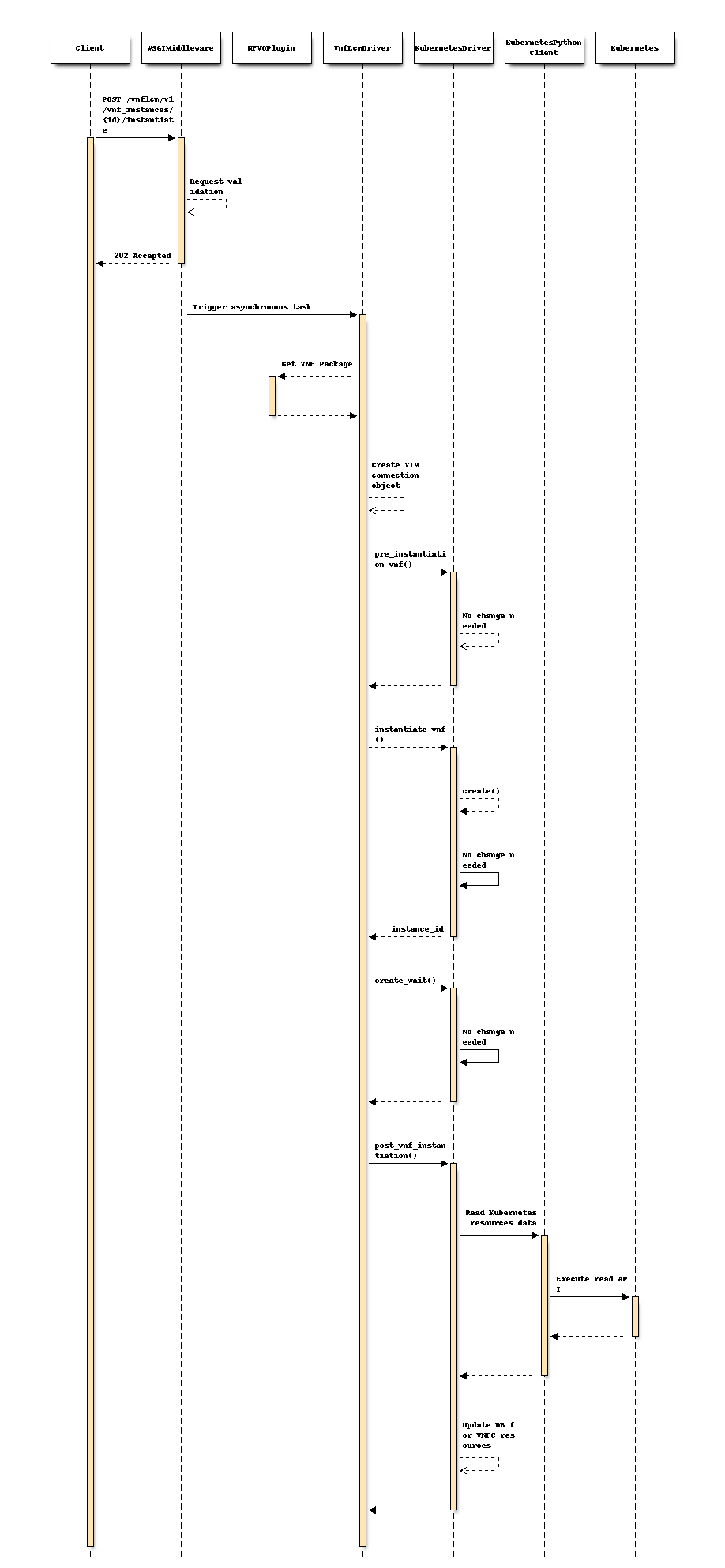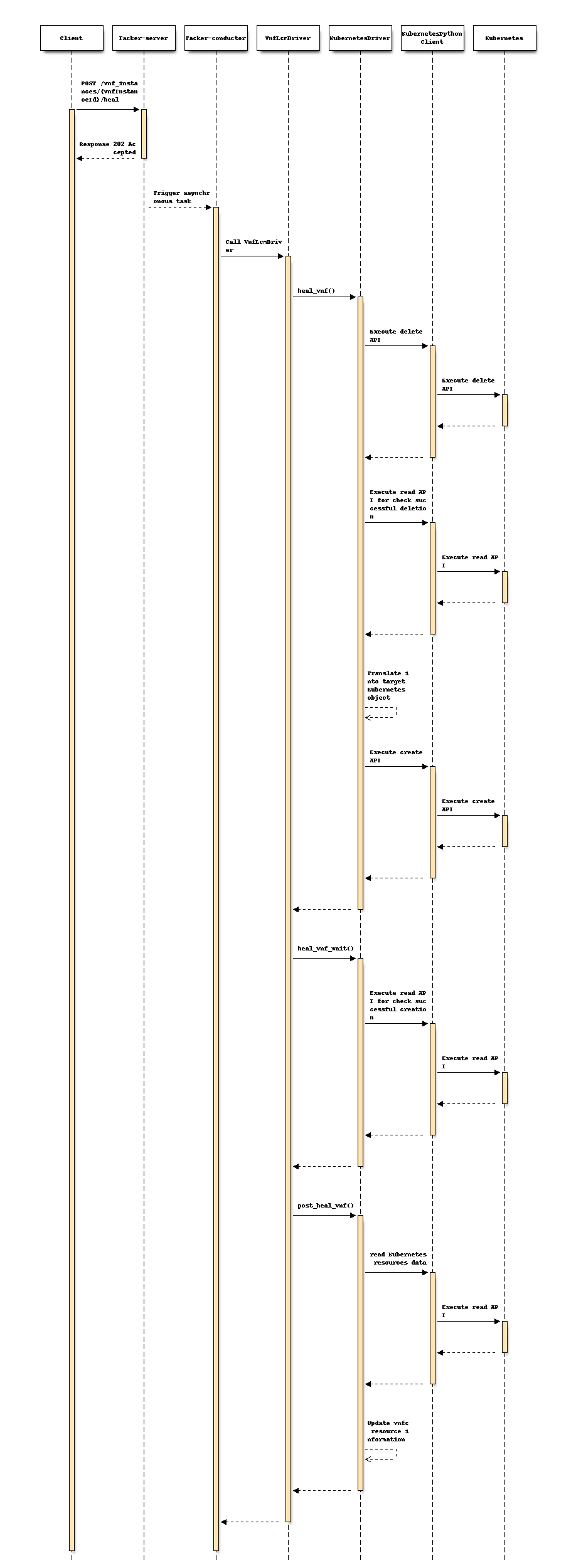Support Heal operation for CNF¶
https://blueprints.launchpad.net/tacker/+spec/support-cnf-heal
This specification describes the “Heal VNF” operation of VNF Lifecycle Management for Container Network Function (CNF) in Tacker.
Problem description¶
In Victoria release, the Instantiate and Terminate VNF operations with VNF
Lifecycle Management defined in ETSI NFV-SOL003 v2.6.1 for CNF are
supported in the spec container-network-function. The CNF heal operation
with ETSI specifications also needs to be implemented. However, the current
ETSI NFV-SOL documents have not defined the detailed specifications for OS
container based VNF. This spec provides the definition of the heal operation
for CNF in Tacker and also the design to be implemented.
According to ETSI NFV-SOL documents, two different types of heal operations are defined:
Heal VNF instance with SOL003
Heal VNFC with SOL002
Proposed change¶
This spec proposes the definition of the heal operation and its design to be implemented.
Definition of CNF healing¶
For “Heal VNF instance with SOL003”, the heal operation is defined to be the termination and instantiation of the VNF.
For “Heal VNFC with SOL002”, Pod is mapped to VNFC. Pod can be a singleton or can be created using a controller resource in Kubernetes such as Deployment, DaemonSet, StatefulSet, or ReplicaSet. The heal operation is defined to delete the Pod. When the Pod is a singleton, a new Pod need to be created while the respawn of Pod is not required for the case of controller resources because a new Pod is automatically created by Kubernetes.
Note
The following are defined in Kubernetes as controller resources:
Deployment
DaemonSet
StatefulSet
ReplicaSet
Job
CronJob
Tacker will support the heal operation for singleton Pod or Pod that created using Deployment, DaemonSet, StatefulSet, and ReplicaSet. Pod that created using Job and CronJob is out of scope because no heal operation is required.
When Users execute “Heal VNF instance with SOL003”, all Kubernetes resources described in VNF Package are re-created, but, for the case of StatefulSet, assigned PersistentVolume by the PersistentVolumeClaim which is automatically created by Kubernetes is not deleted. Also, in “Heal VNFC with SOL002”, only the Pod specified with the provided VNFC ID is re-created and other related resources are not deleted.
Design of heal operation¶
Before the heal operation, CNF containing the resources need to be instantiated. Kubernetes Infra Driver needs following changes:
To validate the target Kubernetes resource to support the heal operation
To heal VNFC by re-create singleton Pod.
To heal VNFC by delete Pod that created using following Kubernetes controller resources:
Deployment
DaemonSet
StatefulSet
ReplicaSet
To store and update the VNFC resource information for the heal operation
Note
The heal operation for VNF instance with SOL003 has been already implemented to be the termination and instantiation of VNF.
The diagram below shows the CNF heal operation for instantiated CNF:
+--------------------+
| Heal Request with |
| additional Params |
+--------+-----------+
| 1. Request heal
| CNF
+--------+----------------+
| v |
| +-------------------+ |
| | Tacker-server | |
| +-----+-------------+ |
| | |
| v |
| +--------------------+ |
2. Heal CNF | | +--------------+ | |
+--------+-+--| Kubernetes | | |
+------------------+ 3. Re-create | | | | Infra Driver | | |
| | VNF or VNFC v | | +--------------+ | |
| +-----+ +-----+ | +------------+ | | | |
| | Pod | | Pod |<-+-------------| Kubernetes | | | | |
| +-----+ +-----+ | | cluster | | | | |
| | | (Master) | | | | |
| Kubernetes | +------------+ | | Tacker conductor | |
| cluster (Worker) | | +--------------------+ |
+------------------+ +-------------------------+
Tacker-server receives the heal request from user
Kubernetes Infra Driver calls Kubernetes client API for healing (delete Pod, or delete and create Kubernetes resources)
Kubernetes Master node re-creates pods running on worker nodes
Sample VNFD file:
VNFD needs to have VDU defined as resource name. The following is a sample
of Deployment.
tosca_definitions_version: tosca_simple_yaml_1_2
description: Deployment flavour for Kubernetes Cluster with
"pre_installed" flavour ID
imports:
- etsi_nfv_sol001_common_types.yaml
- etsi_nfv_sol001_vnfd_types.yaml
topology_template:
inputs:
descriptor_id:
type: string
descriptor_version:
type: string
provider:
type: string
product_name:
type: string
software_version:
type: string
vnfm_info:
type: list
entry_schema:
type: string
flavour_id:
type: string
flavour_description:
type: string
substitution_mappings:
node_type: Company.Tacker.KubernetesCluster
properties:
flavour_id: pre_installed
node_templates:
VNF:
type: Company.Tacker.Kubernetes
properties:
flavour_description: The pre_installed flavour
curry-test001:
type: tosca.nodes.nfv.Vdu.Compute
properties:
name: curry-test001
description: Deployment of Kubernetes resource
vdu_profile:
min_number_of_instances: 1
max_number_of_instances: 3
Note
For Heal operation, Users need to describe
tosca.nodes.nfv.Vdu.Compute in their VNFD because Tacker stores
VnfcResourceInfo in VnfInstance.InstantiatedVnfInfo with the data
type.
Sample Kubernetes object file:
The sample is an example of Deployment.
apiVersion: apps/v1
kind: Deployment
metadata:
name: curry-test001
namespace: curryns
spec:
replicas: 2
selector:
matchLabels:
app: webserver
template:
metadata:
labels:
app: webserver
scaling_name: SP1
spec:
containers:
- env:
- name: param0
valueFrom:
configMapKeyRef:
key: param0
name: curry-test001
- name: param1
valueFrom:
configMapKeyRef:
key: param1
name: curry-test001
image: celebdor/kuryr-demo
imagePullPolicy: IfNotPresent
name: web-server
ports:
- containerPort: 8080
resources:
limits:
cpu: 500m
memory: 512M
requests:
cpu: 500m
memory: 512M
volumeMounts:
- name: curry-claim-volume
mountPath: /data
volumes:
- name: curry-claim-volume
persistentVolumeClaim:
claimName: curry-pv-claim
terminationGracePeriodSeconds: 0
The following heal parameters for “POST /vnf_instances/{id}/heal” are needed
as HealVnfRequest data type defined in ETSI NFV-SOL002 v2.6.1:
Attribute name
Parameter description
vnfcInstanceId
Indicates the target of Kubernetes resource, user can find “vnfcInstanceId” in
InstantiatedVnfInfo.vnfcResourceInfoprovided by “GET /vnf_instances/{id}”.cause
Not needed.
additionalParams
Not needed.
healScript
Not needed.
Kubernetes resource information needs to be stored as “vnfcResourceInfo” in InstantiatedVnfInfo during the CNF instantiate operation. The type “vnfcResourceInfo” is defined in ETSI NFV-SOL003 v2.6.1. The Kubernetes resource information will be stored in “vnfcResourceInfo” as follows:
Attribute name
Cardinality
Parameter description
id
1
UUID of vnfc
vduId
1
VDU name defined in VNFD
computeResource
1
Store information of Pod
> vimConnectionId
0..1
Not needed
> resourceProviderId
0..1
Not needed
> resourceId
1
Pod name that is got information from Kubernetes cluster after the Pod is created
> vimLevelResourceType
0..1
Store Kubernetes resource kind:
Singleton Pod: “Pod”
Pod created by controller resource: Controller resource kind such as “Deployment” and so on
storageResourceIds
0..N
Not needed
reservationId
0..1
Not needed
vnfcCpInfo
0..N
Not needed
>id
1
Not needed
>cpdId
1
Not needed
>vnfExtCpId
0..1
Not needed
>cpProtocolInfo
0..N
Not needed
>vnfLinkPortId
0..1
Not needed
>metadata
0..1
Not needed
metadata
0..1
metadata in Kubernetes object file
The “vnfcResourceInfo.metadata” data type is not well designed to store the
information of CNF. Therefore, the metadata fields need to store metadata
and spec.template.metadata defined in Kubernetes object files to keep the
both of metadata for Controller resource and Pod.
{
"metadata": {
"Deployment": {
"name": "curry-test001",
"namespace": "curryns"
}
"Pod": {
"labels": {
"app": "webserver",
"scaling_name": "SP1"
}
}
}
}
The above is an example of Deployment.
The “key” in “metadata” is set to Kubernetes resource kind such as “Deployment” and so on. And “value” in “metadata” is set to “metadata” in each definition, in this case is set to follow:
The value of “Deployment” is set to
Deployment.metadata(json format)The value of “Pod” is set to
Deployment.spec.template.metadata(json format)
Note
Pod name that is stored in computeResource is different from
the actual Pod name which acts in Kubernetes cluster because Pod name may
change when Kubernetes auto-healing or auto-scaling works. DB needs to be
synchronized during CNF scaling and healing.
Store VNFC resources information in Instantiate VNF¶
During the operation of Instantiate CNF, it needs to store above VNFC resource information. The following sequence diagram describes the components involved and the flow of CNF instantiation operation:

Tacker receives POST request for instantiate CNF, and Kubernetes resources are created and validated creation which processing is implemented in
Victoriarelease.In “post_vnf_instantiation()” method, KubernetesDriver sends read API request to KubernetesPythonClient to store information about resources such as pods, storage and so on to
vnfcResourceInfoif needed.
Note
Need to update DB for VNFC resources also after scaling or healing CNF because of Pod name will be changed after those operations.
Heal VNF instance with SOL003¶
If user does not specify any vnfcInstanceId, the heal operation runs the terminate and instantiate operations for re-creating entire VNF instance. No change is required from the current implementation described in the spec etsi-nfv-sol-rest-api-for-VNF-deployment.
Note
When instantiating CNF during the heal operation, change the number of replicas by reading “InstantiatedVnfInfo.scale_status” stored after the scaling operation.
Heal VNFC with SOL002¶
If user specify vnfcInstanceId, VNFC which is the controller resource in Kubernetes such as Deployment, DaemonSet, StatefulSet, or ReplicaSet is the target of the heal operation and it enables to respawn the VNFC instance.
The following is a sample of healing request body:
{
"vnfcInstanceId": "311485f3-45df-41fe-85d9-306154ff4c8d"
}
The following sequence diagram describes the components involved and the flow of the CNF heal operation:

Client sends a POST request to the Heal CNF Instance resource.
Basically the same sequence as the one described in the spec support-notification-api-based-on-etsi-nfv-sol, except for the Tacker-conductor. In case of CNF heal operation, the MgmtDriver action is not need.
KubernetesDriver sends delete and read API request to Kubernetes with KubernetesPythonClient to delete the Kubernetes resources and check deletion is successful in heal_vnf() method.
If deletion is successful, the definition of heal target resources is extracted from Kubernetes object YAML files will be translated into Kubernetes model object, and KubernetesDriver sends create API request to Kubernetes with KubernetesPythonClient to re-create the Kubernetes resources.
Note
No explicit deletion process is required for Pods created by controller resources in Kubernetes such as Deployment, DaemonSet, StatefulSet, or ReplicaSet, because Kubernetes automatically regenerates the Pods.
Note
Change the number of replicas in Kubernetes model object by reading “InstantiatedVnfInfo.scale_status” stored after the scaling operation.
KubernetesDriver sends read API request to Kubernetes with KubernetesPythonClient to check creation result in heal_vnf_wait() method.
VnfLcmDriver updates VNFC resource information by reading Kubernetes resource to “VnfInstance.InstantiatedVnfInfo.vnfcResourceInfo” if creation is successful in post_heal_vnf() method.
Alternatives¶
None
Data model impact¶
None
REST API impact¶
None
Security impact¶
None
Notifications impact¶
None
Other end user impact¶
None
Performance Impact¶
None
Other deployer impact¶
None
Developer impact¶
None
Implementation¶
Assignee(s)¶
- Primary assignee:
Yoshito Ito <yoshito.itou.dr@hco.ntt.co.jp>
- Other contributors:
Ayumu Ueha <ueha.ayumu@fujitsu.com>
LiangLu <lu.liang@fujitsu.com>
Work Items¶
Validate the target Kubernetes resource to support heal operation
Kubernetes Infra Driver will be modified to implement:
Heal VNFC by re-create singleton Pod.
Heal VNFC by delete Pod that created using following Kubernetes resource kind:
Deployment
DaemonSet
StatefulSet
ReplicaSet
Store and update the VNFC resource information for the heal operation
Add new unit and functional tests.
Dependencies¶
None
Testing¶
Unit and functional tests will be added to cover cases required in the spec.
Documentation Impact¶
Complete user guide will be added to explain CNF healing.
References¶
None
